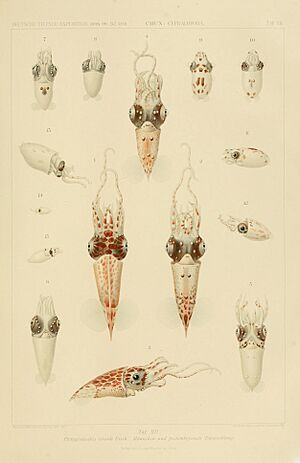Pterygioteuthis giardi facts for kids
Quick facts for kids Pterygioteuthis giardi |
|
|---|---|
 |
|
| Conservation status | |
| Scientific classification |
The Pterygioteuthis giardi is a type of squid also known as the roundear enope squid. It belongs to the Pyroteuthidae family. Its scientific name, giardi, was chosen to honor Alfred Mathieu Giard. He was a French zoologist and marine biologist who lived from 1846 to 1908.
Contents
About the Roundear Enope Squid
What Does It Look Like?
Squid in the Pyroteuthidae family have special light-producing organs. These are called Photophores. They are found on their internal organs, on the stalks of their tentacles, and under their eyes. There are five large and ten small photophores under each eye.
This squid has a wide, triangular body, called a mantle. The back end of its mantle is rounded. It also has rounded fins at the top, near the end of its mantle. Their mantles are usually less than 34 millimeters long.
Their tentacles look like clubs that are bent. This is because they are always constricted. Adult Pterygioteuthis squid do not have hooks on their tentacle clubs. However, they do have some hooks on their arms.
Male squid have a special arm called a hectocotylus. They use this arm to transfer sperm to the females. Female squid do not have suckers on their bottom arms. They also only have one developed oviduct, which is used for reproduction.
Where Do These Squid Live?
Squid in the Pyroteuthidae family live in the mesopelagic zone during the day. This is also known as the midwater or twilight zone. At night, they move up to the epipelagic waters. These waters are closer to the surface, from 0 to 200 meters deep.
We don't know much about the full life of these squid. This is because they are hard to study in their natural home. However, one study looked at a similar squid, P. gemmata. It found that this squid lived for about 78 days. Scientists think other squid in the Pyroteuthidae family might have similar short lives.
We also don't know much about what P. giardi eats specifically. But a study in the eastern Gulf of Mexico looked at what different cephalopods eat. It found that P. giardi eats small crustaceans, like copepods.
P. giardi lives in the Atlantic Ocean. You can find them between 40 degrees North and 34 degrees South. They also live in the cooler parts of the Pacific Ocean, both north and south. But they are not found in the eastern tropical Pacific.
Near Hawaii, more P. giardi were found on the side of the island protected from the wind. This was compared to the windy side. Scientists think P. giardi might be a "facultative-boundary species." This means they can live where the deep ocean meets the coast. They don't have to, but they can survive there.
Who Eats the Roundear Enope Squid?
Many different animals eat P. giardi. The predators depend on where the squid lives. Some large dolphins and fish eat them. In the South Pacific, a study found that the Guadalupe Fur Seal also hunts P. giardi.
How Do They Behave?
Scientists have done experiments with P. giardi in labs. They saw that the squid can make a flash of light when they get a small electric shock. It is likely that these squid use these light flashes to protect themselves from predators.
Animals with photophores often use light for other reasons too. They might use flashes to attract prey to eat. They could also use them to find a mate.
P. giardi can also use Counter-illumination. This means they use light from their photophores to hide their shape. They do this in light conditions similar to the upper mesopelagic zone. This helps them blend in with the light coming from above.
How Scientists Classify Them
P. giardi is part of a group that includes P. hoylei. P. hoylei was first thought to be a type of giardi. But in 1987, it was changed to its own species. Now, P. giardi and P. hoylei are considered "sister species." This means they are very closely related.
Protecting the Roundear Enope Squid
The P. giardi is listed as a "least concern" species on the IUCN Red List. This means they are not currently in danger. However, scientists say we need to study them more. We need to learn about their population size, how long they live, and what threats they face.



